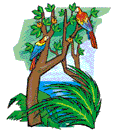How Animals Adapt to their Environment
A lesson and worksheet on how animals adapt to their environment.
Objectives:
• Students will be able to define adaptation
• Students will understand that animals have various ways of adapting to the environment.
• Students will be able to describe how animals use camouflage and mimicry to adapt to their environment.
• Students will be able to distinguish inherited behaviors from learned behaviors.
Suggested Grades:
3rd Grade - 4th Grade - 5th Grade
Print the reading comprehension worksheet passage and questions (see below).
Students should read the passage silently, then answer the questions. Teachers may also use the text as part of a classroom lesson plan.
Lesson Excerpt:
If you are cold, you might put on a jacket. This is one way that you adapt to the environment. Animals also adapt to their environments. Adaptations help animals survive weather conditions, predators and other situations that might otherwise cause them harm.
One interesting way that animals adapt is by mimicry. Some animals that are not very harmful by nature can "mimic" or act like animals that are. For example, there is an insect called a syrphid that looks very much like a yellow jacket. Humans know that yellow jackets can give painful stings, so if we see a syrphid, we will probably avoid it even though it is harmless. Similarly, birds avoid eating a type of butterfly known as a viceroy butterfly simply because it looks very much like a monarch butterfly. Monarch butterflies taste awful to birds.
Continued...

Lesson Printables:
Print this printable worksheet for this lesson:


